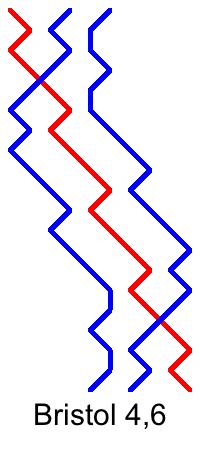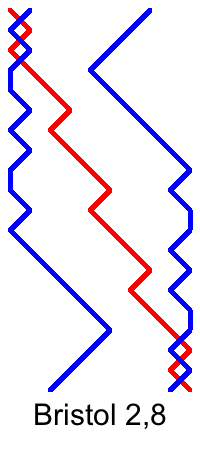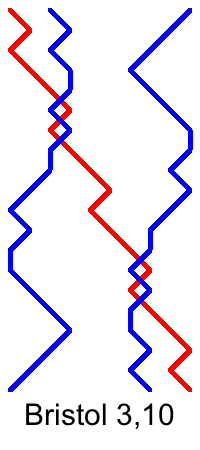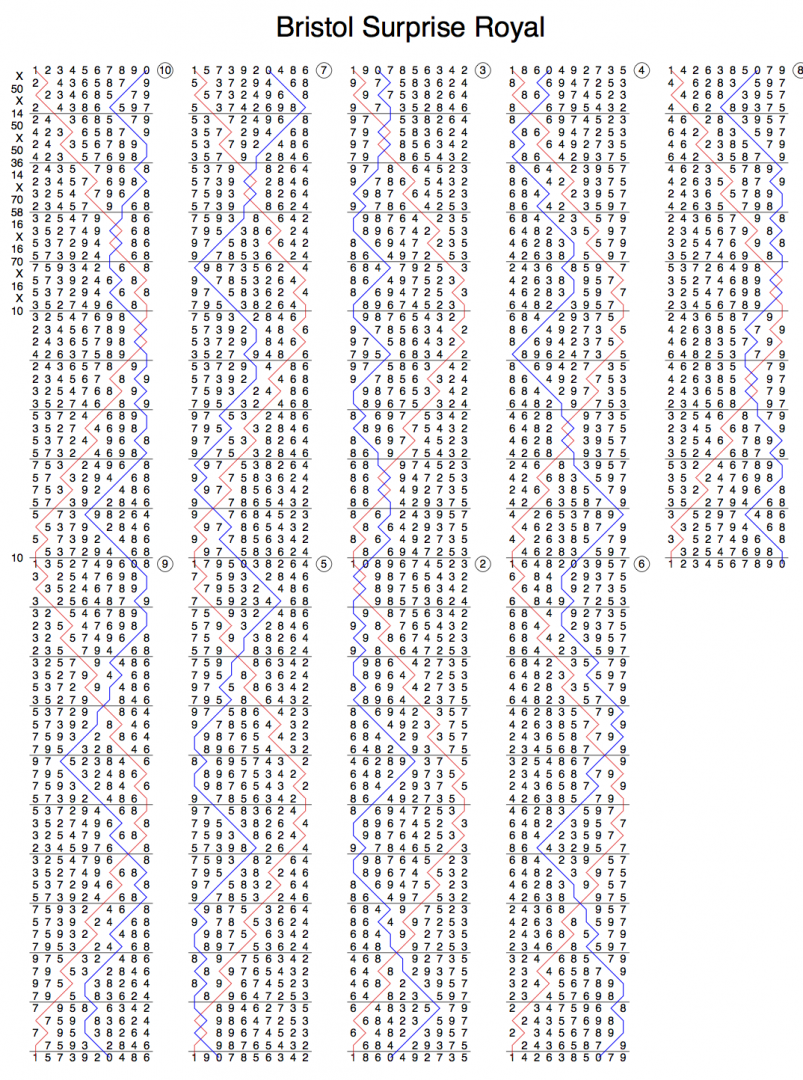On Monday we were joined by Nick for another Bristol Royal session, without the distraction of ringing London first. We agreed that we would set out for a plain course, and if we got to the end, I would call a wrong and keep going for a quarter.
It started very well - a complete transformation in comparison with last time. As I remember, we got past the lead end where all the pairs cross. I remember thinking "wow, we're going to have to continue for a quarter - but I don't know whether I can keep up this concentration for long enough!" It didn't last though - we broke down a couple of leads later. Nevertheless, it was so much better than our first attempt, that it suddenly seemed possible.
We followed the usual technique of restarting at problematic leads, and practising until we had rung the whole course in sections. Then we managed a whole plain course at the end of the evening. It felt like a real breakthrough. Unfortunately it will be a while before we can get together again - probably November - but Tina and I might have a chance to ring it next week on our ringers' group holiday.
We had particular difficulty with the lead in which the tenors are 4th and 6th place bells. I then realised that this is the lead in which the first half lead has all the pairs ringing rotationally symmetric patterns (I wrote about this when we were working on 23 spliced). As I said before, it can feel quite awkward to be doing the same work with both bells, but turned upside down and backwards. Strangely, the lead in which the second half lead is rotationally symmetric, which is when the tenors are 7th and 9th place bells and occurs earlier in the course, seemed much easier. Nick suggested that it's easier to get through a difficult second half lead, because we have a better idea of which place bells we are aiming for, instead of aiming for the half lead as a landmark.
Here are the rotationally symmetric pieces of work for each pair. From left to right: 9-10, 7-8, 5-6, 3-4.




They do look rather tricky!
Another tricky aspect of Bristol Royal, which doesn't occur in Major, is the wrong dodges. In particular, it's possible to do a wrong dodge with one bell and a right dodge (dodging with the treble) with the other bell. An example is the relationship between 9th place bell, in the diagram above, and the treble. The bells move in parallel for two changes, but for one of them it's a right hunting step followed by a right dodge, and for the other it's a wrong dodge followed by a wrong hunting step. This is different from moving in parallel in a coursing position, because there are two bells between, instead of one.
When writing blogs about the methods we are ringing, I usually focus more on the inside pairs, because that's what I ring. But let's spare a thought for Angela and have a look at the trebles.

Most place bells have the right/wrong dodging feature. It occurs when the treble is in 5-6, so the other bell can be adjacent (3-4 or 7-8) or further away (1-2 or 9-10). Also distinctive, and tricky, are the sections where the trebles are almost coursing, but two bells apart instead of one bell apart, with the treble right hunting and the second wrong hunting. This is in 9th, 7th, 4th and 6th place bells. The offset dodging causes them to ring adjacently, then separate again to two apart. Angela said that this took some getting used to. The same thing happens in Bristol Maximus, but continues for longer.
There was a lot of announcing of points going on, mostly by me. I have always found it slightly more difficult to announce the points if I'm not doing one myself. During the evening, I realised that when ringing 7-8 (which I was), or 5-6, every time there's a point, one or both of my bells is involved in it. That made it easier. It's only the coursing or 3-4 pairs that can be outside the points, at the same end of the change as the treble.
When considering which composition to call for a quarter peal (if we had got that far), there were a few reasonable options. For ringing in the tower, W H W H is a standard favourite, which I have called from the 5th a couple of times (it's just like calling Plain Bob Minor: 4ths and out twice, then home). It also has the advantage of ringing the whole plain course before the first bob, which is what I wanted for our session. However, 3-4 have to ring three positions (3-4, 7-8 and coursing) and 5-6 also have to ring three positions (5-6, 3-4 and 7-8).
Another possibility is H sH H sH, which can be massaged into starting at the snap and calling W sW W sW, which keeps 5-6 coursing throughout and only has the coursing and 3-4 positions for 3-4. But it's four 8-lead courses, so it isn't all-the-work, which seems undesirable.
After a while I realised that sW sH sW sH is also true, and it keeps 3-4 in the 3-4 position throughout. 5-6 ring 5-6 and 3-4. I haven't seen this composition written down before for Bristol Royal. It has fewer 4-bell runs than some of the others. But I think it's the best calling for our first quarter, when we get the chance to try again.